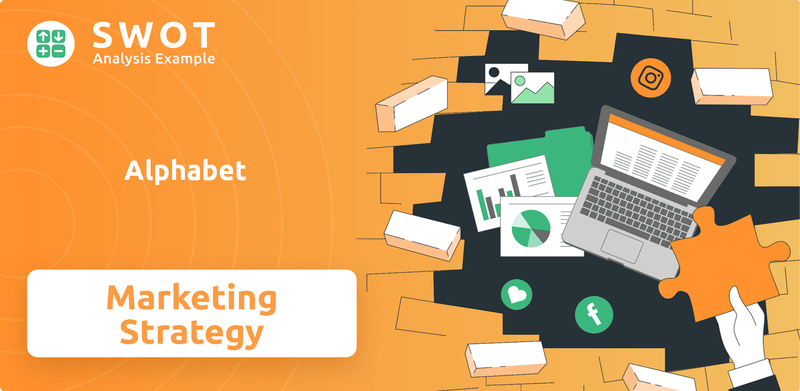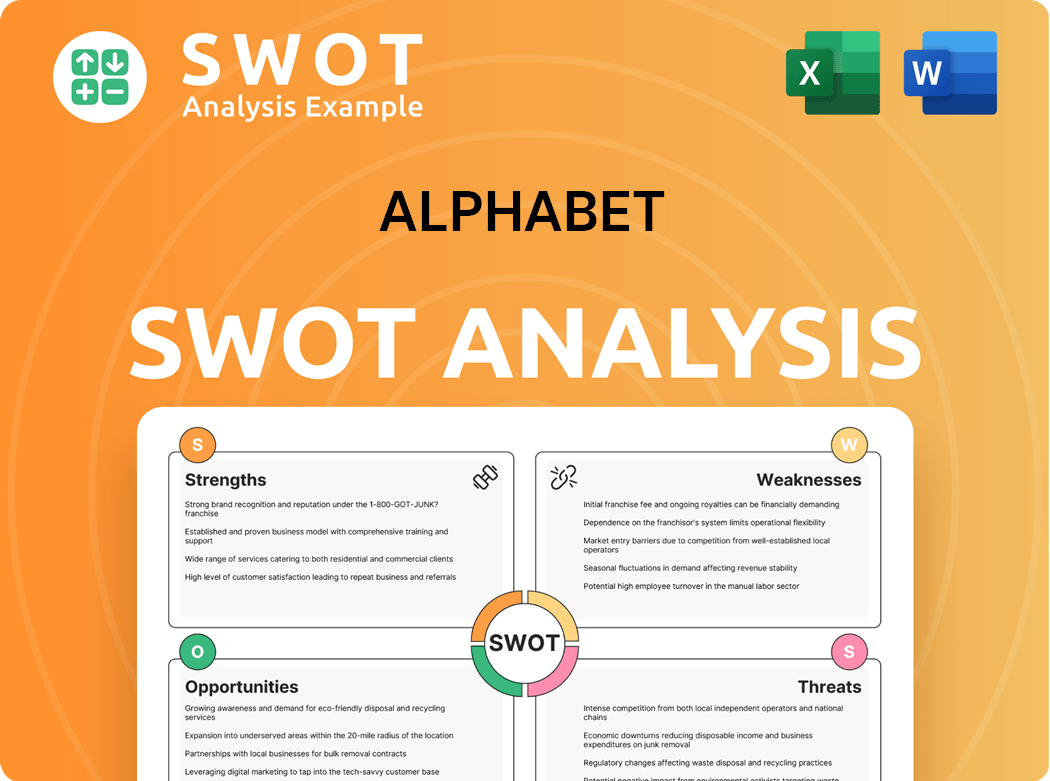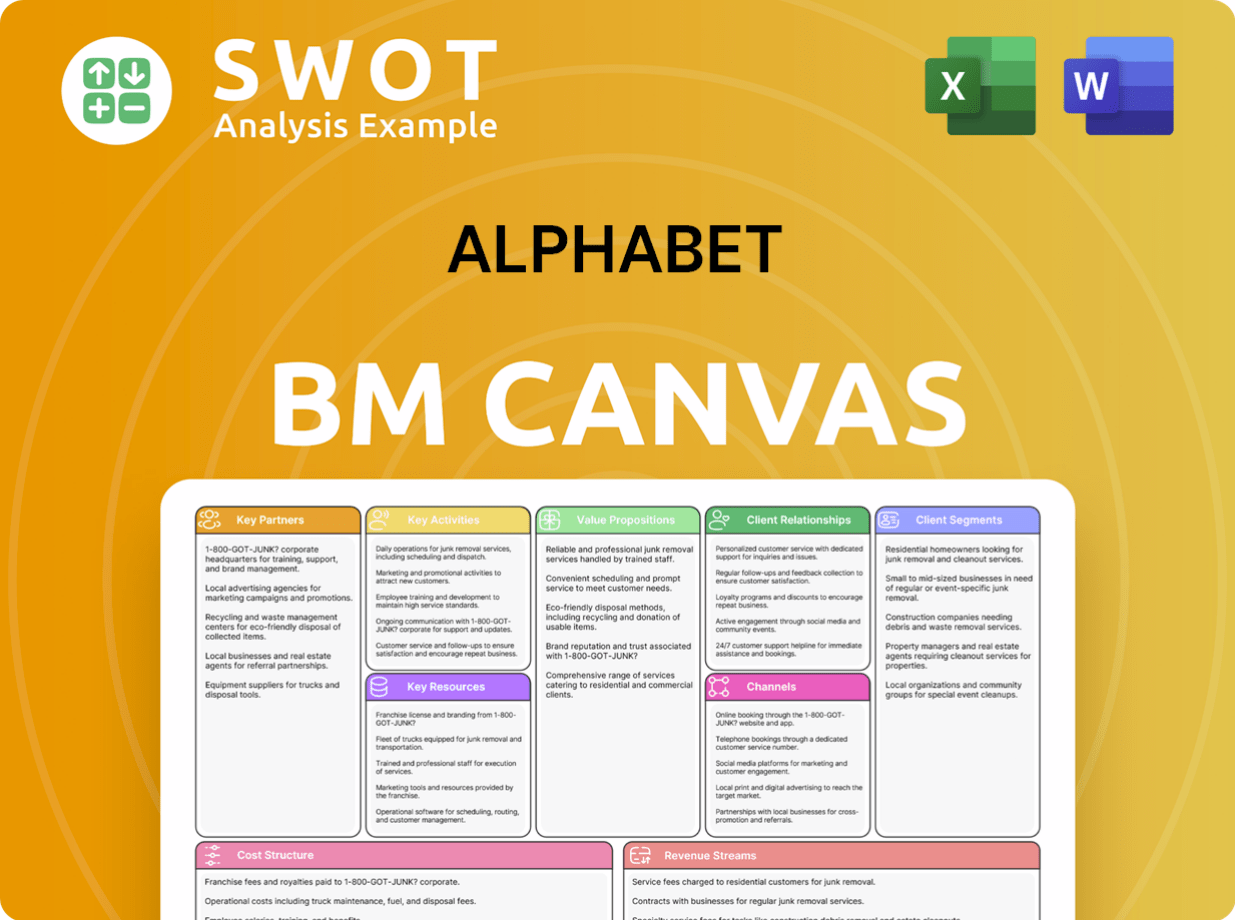Alphabet Bundle
How Does Alphabet Dominate the Digital World?
Alphabet Inc., the powerhouse behind Google, has consistently redefined the digital sphere, and its Alphabet SWOT Analysis reveals the secrets behind its success. From its inception, a pivotal branding decision—the 2015 restructuring into a holding company—fundamentally altered its trajectory. This strategic move enabled Google's diverse ventures, from search and advertising to cutting-edge innovations, to flourish under a unified vision.

This exploration delves into Alphabet's intricate sales and marketing strategies, analyzing how it generates substantial Alphabet revenue and maintains its competitive edge. We'll dissect its innovative Google marketing tactics, examine the evolution of its Alphabet sales and marketing approaches, and evaluate its responses to the dynamic challenges of the digital landscape, including its Alphabet competition.
How Does Alphabet Reach Its Customers?
Understanding Alphabet's sales channels is crucial to grasping its revenue generation. The company employs a multifaceted sales approach, blending online and offline strategies to reach its diverse customer base. This integrated approach supports its substantial revenue streams, as detailed in the Revenue Streams & Business Model of Alphabet.
Alphabet's sales and marketing strategies are tailored to each product and service segment. The core Google Services segment, with its significant advertising revenue, relies heavily on online channels. Hardware products and the rapidly growing Google Cloud segment utilize a mix of online and offline channels, including direct sales and partnerships.
This flexible strategy allows Alphabet to maximize its market reach and adapt to changing consumer behaviors. By examining its sales channels, we gain insights into how Alphabet maintains its market position and drives growth.
The primary sales channel for Google Services is online, particularly through Google Ads. This self-service platform enables millions of advertisers to buy targeted advertising space. YouTube, a key component, generated $36 billion in ad revenue in 2024.
For hardware products like Pixel phones and Nest devices, Alphabet uses its own e-commerce platforms and third-party retail partners. This hybrid approach broadens consumer reach. Specific sales figures for these channels in 2024-2025 are not readily available.
Google Cloud relies on direct sales teams and strategic partnerships to drive growth. Revenues increased significantly, with a 30% rise to $12.0 billion in Q4 2024 and 28% to $12.3 billion in Q1 2025. This strategy targets a broad range of clients, from startups to large enterprises.
Alphabet continues to adapt its sales and marketing strategies. The introduction of new leadership roles, such as Chief Digitalization Officer, underscores its commitment to digital transformation. This focus aims to enhance sales and marketing efforts across all segments.
Alphabet's sales strategy is a dynamic mix of online and offline channels, tailored to each product segment. The company's digital marketing strategy is heavily reliant on Google Ads, while hardware utilizes a hybrid approach. Google Cloud emphasizes direct sales and partnerships.
- Google Ads is a self-service e-commerce platform.
- YouTube ad revenue reached $36 billion in 2024.
- Google Cloud saw significant revenue growth in Q4 2024 and Q1 2025.
- The company is investing in digital transformation to enhance sales and marketing.
Alphabet SWOT Analysis
- Complete SWOT Breakdown
- Fully Customizable
- Editable in Excel & Word
- Professional Formatting
- Investor-Ready Format

What Marketing Tactics Does Alphabet Use?
The marketing tactics employed by Alphabet are extensive, with a strong emphasis on digital channels and the increasing integration of artificial intelligence. This approach is central to its overall sales and marketing strategy, ensuring a wide reach and targeted engagement with its diverse audience. The company's marketing efforts are data-driven, customer-centric, and designed to maximize both brand visibility and conversion rates.
Digital marketing is a core component, with a focus on search engine optimization (SEO) to enhance visibility on its platforms and products. Paid advertising, primarily through Google Ads, remains a key element, enabling highly targeted campaigns based on various parameters. Content marketing and social media marketing are also vital, helping to engage with the target audience.
A significant evolution in Alphabet's marketing approach is the increasing integration of artificial intelligence (AI). AI-driven tools streamline creative production, optimize ad targeting, and offer deeper insights into customer behavior. This comprehensive strategy supports Alphabet's goal of maintaining a competitive edge in the market.
Digital marketing is at the forefront of Alphabet's sales strategy, with a strong emphasis on search engine optimization (SEO) to enhance visibility. Paid advertising, primarily through Google Ads, is a cornerstone, enabling highly targeted campaigns.
Alphabet is heavily integrating artificial intelligence (AI) into its marketing strategies. This includes AI-powered enhancements for ad campaigns, image generation, and personalized user experiences.
Content marketing is extensively utilized across various platforms, including blogs and news pages, to provide updates and product news. Social media marketing is also a vital tactic, leveraging platforms like Facebook, Instagram, and X.
Data-driven marketing, customer segmentation, and personalization are deeply embedded in Alphabet's strategy. Tools like BigQuery and Google Analytics 360 are used to analyze data and build advanced audience segments.
Google's advertising revenue is a significant revenue stream. In Q4 2024, Google's advertising revenue reached $72.46 billion, marking a 10.6% year-over-year increase. Analysts anticipate annual advertising revenues to reach $273.37 billion in 2024.
The company's search algorithm updates emphasize rewarding high-quality, helpful content. This focus on valuable and relevant content is a key part of the overall strategy.
Alphabet's marketing strategy is a blend of digital prowess, AI integration, and data-driven decisions. This comprehensive approach supports the company's goals for sales growth and market share. For a deeper dive into how these strategies contribute to the company's overall success, consider reading about the Growth Strategy of Alphabet.
- SEO: Ensuring prominent placement in search results for its platforms and products.
- Paid Advertising: Utilizing Google Ads for targeted campaigns based on demographics and interests.
- Content Marketing: Creating valuable content across various platforms to engage users.
- Social Media Marketing: Leveraging platforms like Facebook, Instagram, and X to connect with audiences.
- AI Integration: Implementing AI-powered tools for ad optimization, creative production, and customer insights.
- Data-Driven Marketing: Utilizing data analytics to personalize campaigns and improve customer segmentation.
Alphabet PESTLE Analysis
- Covers All 6 PESTLE Categories
- No Research Needed – Save Hours of Work
- Built by Experts, Trusted by Consultants
- Instant Download, Ready to Use
- 100% Editable, Fully Customizable

How Is Alphabet Positioned in the Market?
Alphabet Inc. strategically positions itself as a global technology leader, emphasizing its commitment to organizing the world's information and making it universally accessible. This core message underpins its entire brand identity, focusing on innovation, utility, and a user-centric approach. The brand's visual identity, particularly through its Google subsidiary, is characterized by simplicity, vibrant colors, and a clean design, reflecting its approachable and intuitive products. The tone of voice is generally helpful, informative, and forward-thinking.
The company differentiates itself from competitors through its extensive ecosystem of interconnected products and services. This creates a seamless user experience across search, mobile (Android), cloud computing (Google Cloud), productivity tools (Google Workspace), and entertainment (YouTube). This comprehensive offering fosters strong customer loyalty and provides extensive data for continuous product improvement and personalized experiences. It consistently delivers cutting-edge technology that simplifies tasks, enhances productivity, and provides access to information, appealing to a broad target audience.
Alphabet's brand perception and market leadership are underscored by its sustained financial performance and market capitalization. As of June 2024, its market capitalization was approximately $2.0 trillion. In Q4 2024, consolidated Alphabet revenues increased by 12% year-over-year to $96.5 billion, and in Q1 2025, revenues grew by 12% to $90.2 billion. The Google Services segment, including Search and YouTube, showed a 10% increase in revenue in both Q4 2024 and Q1 2025, highlighting the continued strength of its core offerings. This strong financial performance is a key indicator of its successful Sales strategy Alphabet and Marketing strategy Alphabet.
Alphabet maintains brand consistency across all channels and touchpoints, from product interfaces to marketing communications. This reinforces its identity as a reliable and innovative technology provider. This consistency is crucial for building and maintaining customer trust and brand recognition.
The company continually responds to shifts in consumer sentiment and competitive threats by investing heavily in research and development, particularly in artificial intelligence. This proactive approach helps Alphabet maintain its competitive edge and reinforces its brand image as a forward-thinking leader. This is a key element of its Alphabet sales and marketing approach.
Alphabet's integration of AI, especially through Gemini and AI Overviews, enhances the core search experience and expands monetization opportunities. AI Overviews currently reaches 1.5 billion users per month. This focus on AI is a significant part of its Google marketing strategy.
Alphabet's vast ecosystem of interconnected products creates a competitive advantage by providing a seamless user experience. This integrated approach fosters customer loyalty and provides valuable data for continuous product improvement. This is a crucial factor in its Alphabet competition strategy.
The company's strong financial performance, with revenue growth in key segments, underscores its successful brand positioning and market leadership. This financial strength supports its ability to invest in innovation and maintain its competitive edge. The ability of Alphabet to generate sales is discussed in detail in the article.
The user-centric approach, focusing on simplifying tasks and enhancing productivity, is a core element of Alphabet's brand positioning. This approach ensures that its products and services meet the needs of its diverse target audience. This focus is key to its Alphabet's digital marketing strategy.
Alphabet Business Model Canvas
- Complete 9-Block Business Model Canvas
- Effortlessly Communicate Your Business Strategy
- Investor-Ready BMC Format
- 100% Editable and Customizable
- Clear and Structured Layout

What Are Alphabet’s Most Notable Campaigns?
The company, through its subsidiaries, consistently launches impactful sales and marketing campaigns, often leveraging its own platforms and AI capabilities. While specific, named consumer-facing campaigns with detailed results for 2024-2025 are not always publicly disclosed with specific metrics like impressions or sales lift, the company's earnings reports and product announcements highlight key strategic initiatives. This approach is crucial for understanding how the company drives revenue and maintains its market position.
One of the main objectives is to highlight the company's leadership in AI and demonstrate how it enhances user experience and business solutions. These initiatives are primarily executed through digital channels, including the company's own platforms, industry events, and thought leadership content. Understanding these strategies is vital for anyone analyzing the company's Competitors Landscape of Alphabet.
Another key area is the ongoing evolution of Google Ads and YouTube advertising. These updates aim to increase conversion rates and ROI for advertisers, with Performance Max users reporting an average 27% increase in conversions. YouTube's ad revenue, which reached $36 billion in 2024, reflects the success of its ongoing efforts to attract and retain advertisers through diverse ad formats and a massive user base.
The continuous integration and promotion of AI across all Google products is a significant ongoing campaign. The rollout of AI Overviews in Google Search, now with 1.5 billion users per month, is a major strategic focus. This drives engagement and improves search utility.
The growth in Google Cloud revenues is significantly led by AI Infrastructure and Generative AI Solutions. Google Cloud saw a 30% increase in Q4 2024 and a 28% increase in Q1 2025, indicating successful sales and marketing efforts. This targets enterprise clients for AI adoption.
At Google Marketing Live 2024, significant AI-driven advancements were unveiled for Performance Max campaigns. These include AI-powered image generation and optimization tools. The goal is to increase conversion rates and ROI for advertisers.
YouTube's ad revenue reached $36 billion in 2024. This reflects the success of efforts to attract and retain advertisers. The platform uses diverse ad formats and has a massive user base.
In response to shifts in the digital advertising landscape, including regulatory scrutiny and privacy concerns, the company emphasizes 'privacy-safe measurement' and 'connected data & insights' as key focus areas for 2025. This involves leveraging tools like Google Analytics 360 and Google Cloud.
- Building trust with users.
- Providing effective solutions in a changing environment.
- Focusing on privacy-safe measurement.
- Leveraging Google Analytics 360 and Google Cloud.
Alphabet Porter's Five Forces Analysis
- Covers All 5 Competitive Forces in Detail
- Structured for Consultants, Students, and Founders
- 100% Editable in Microsoft Word & Excel
- Instant Digital Download – Use Immediately
- Compatible with Mac & PC – Fully Unlocked

Related Blogs
- What are Mission Vision & Core Values of Alphabet Company?
- What is Competitive Landscape of Alphabet Company?
- What is Growth Strategy and Future Prospects of Alphabet Company?
- How Does Alphabet Company Work?
- What is Brief History of Alphabet Company?
- Who Owns Alphabet Company?
- What is Customer Demographics and Target Market of Alphabet Company?
Disclaimer
All information, articles, and product details provided on this website are for general informational and educational purposes only. We do not claim any ownership over, nor do we intend to infringe upon, any trademarks, copyrights, logos, brand names, or other intellectual property mentioned or depicted on this site. Such intellectual property remains the property of its respective owners, and any references here are made solely for identification or informational purposes, without implying any affiliation, endorsement, or partnership.
We make no representations or warranties, express or implied, regarding the accuracy, completeness, or suitability of any content or products presented. Nothing on this website should be construed as legal, tax, investment, financial, medical, or other professional advice. In addition, no part of this site—including articles or product references—constitutes a solicitation, recommendation, endorsement, advertisement, or offer to buy or sell any securities, franchises, or other financial instruments, particularly in jurisdictions where such activity would be unlawful.
All content is of a general nature and may not address the specific circumstances of any individual or entity. It is not a substitute for professional advice or services. Any actions you take based on the information provided here are strictly at your own risk. You accept full responsibility for any decisions or outcomes arising from your use of this website and agree to release us from any liability in connection with your use of, or reliance upon, the content or products found herein.